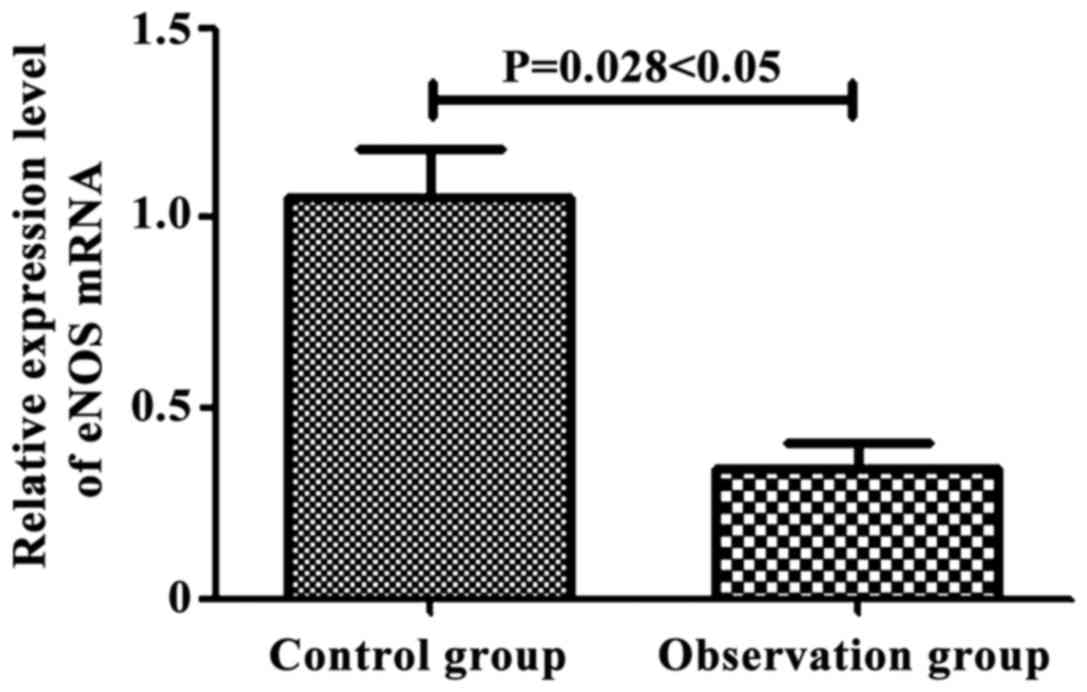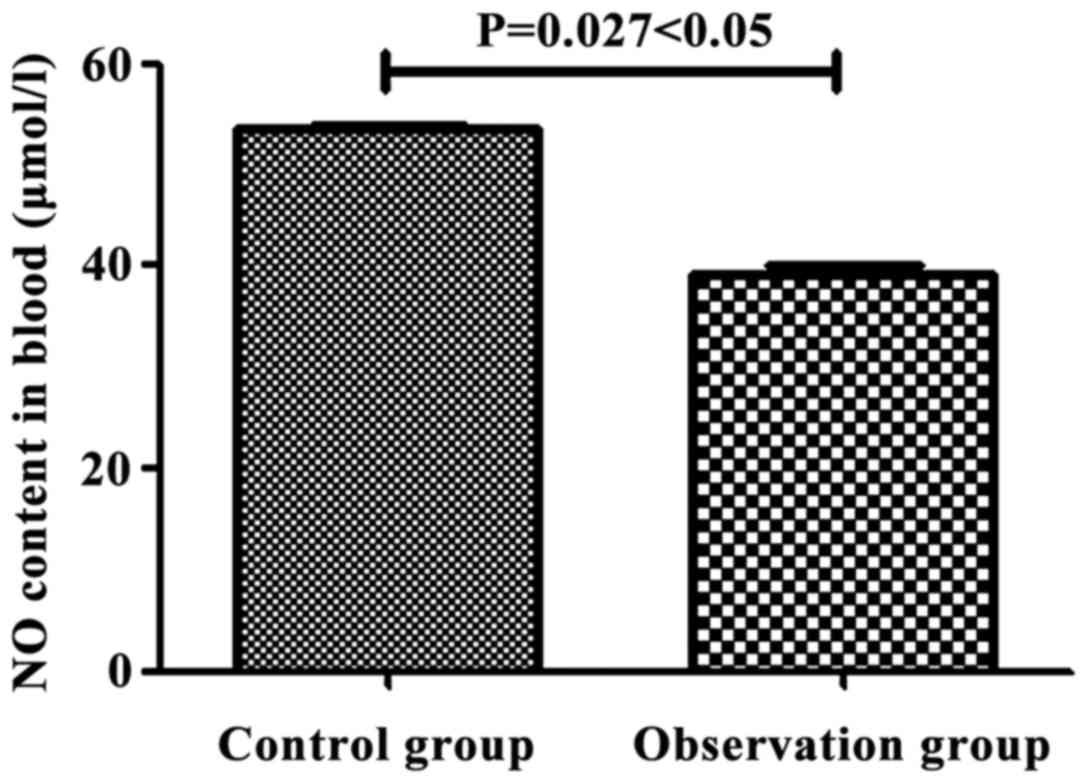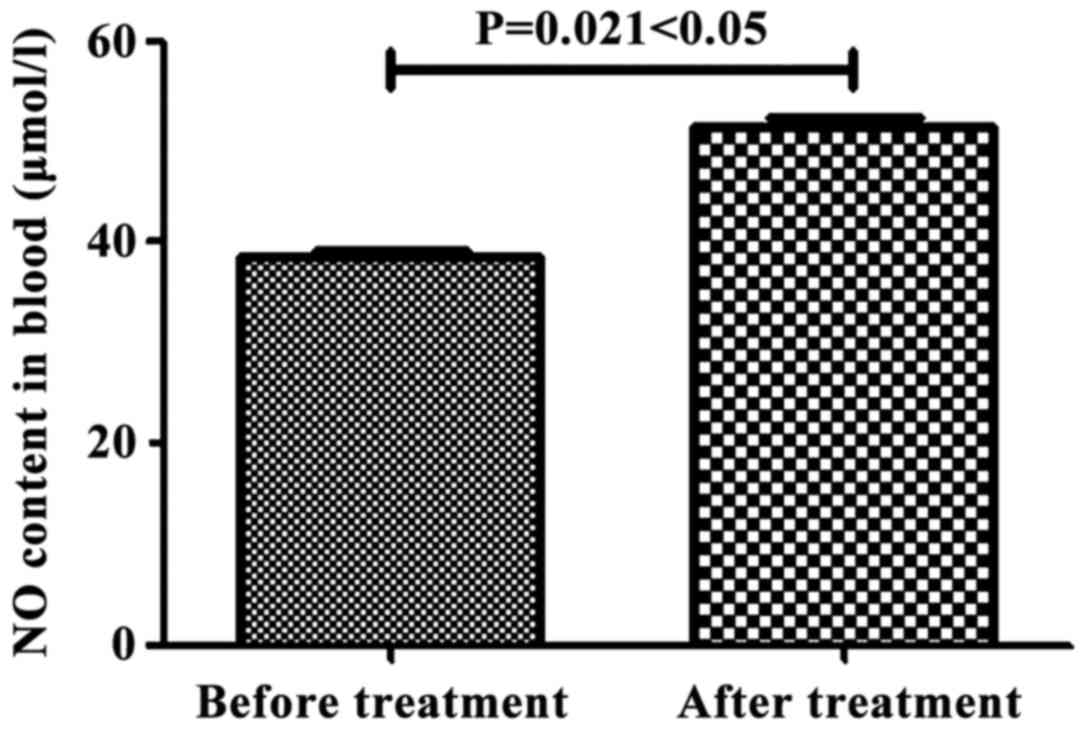Trimetazidine combined with berberine on endothelial function of patients with coronary heart disease combined with primary hypertension
- Authors:
- Published online on: June 8, 2018 https://doi.org/10.3892/etm.2018.6278
- Pages: 1318-1322
Abstract
Introduction
Coronary atherosclerotic heart disease is the vascular occlusion after coronary atherosclerosis, which is caused by external factors. Vascular cavity narrowing and vascular blockage can cause myocardial cells hypoxia, leading to myocardial cell death (1). Recent studies have shown that coronary artery disease (CAD) is not only caused by vascular endothelial dysfunction, but also by vasospasm and thrombosis (2). As important materials with important roles in stimulating endothelial function, levels of NO and coronary heart disease (CHD) were significantly lower in CAD patients than in healthy people (3). Further studies on CAD showed that this disease is mainly caused by vascular obstruction, so many diseases such as hypertension and diabetes can cause CAD (4). Statistical analysis has showed that vascular damage is more serious in CCP patients than in CAD patients (5). Clinical studies have shown that trimetazidine can improve systolic function of CCP patients, but its effect on primary hypertension is not significant (6). As a type of quinoline alkaloid (7), berberine has been proven to be able to reduce blood glucose, improve insulin resistance and reduce blood pressure (8–10). However, the effects of trimetazidine combined with berberine on endothelial function of patients with CPP still have not been reported. In this study, effects of trimetazidine combined with berberine on endothelial function of patients with CPP were studied. This study provides theoretical and experimental basis for further studies.
Materials and methods
General information
In this study, a total of 68 patients with CCP were selected from July 2014 to August 2016 to serve as observation group (all patients were diagnosed as primary hypertension for the first time, and all patients were willing to participate in this study). The patients included 36 males and 32 females with an average age of 65.3±7.3 years. At the same time, a total of 68 healthy people were also selected to serve as control group. Control group included 36 males and 32 females with an average age of 66.1±7.9 years. No significant differences in age were found between two groups. All patients signed informed consent, and this study was approved by the Ethics Committee of Beijing Chaoyang Hospital (Beijing, China).
Inclusion criteria: Patients met the diagnostic criteria of CAD through coronary angiography and primary hypertension by monitoring of blood pressure: systolic pressure ≥140 mmHg and/or diastolic pressure ≥90 mmHg.
Exclusion criteria: i) Patients with hypertriglyceridemia; ii) patients with other forms of hypertension: renal hypertension, aldosteronism and pheochromocytoma; iii) patients with CAD combined with hypertriglyceridemia; iv) patients with CAD combined with type 2 diabetes.
In this study, trimetazidine and berberine were purchased from Servier (Paris, France). RNA extraction kit was purchased from Axygen (Shanghai, China). RT-PCR kit was purchased from Takara Biotechnology Co., Ltd. (Dalian, China). NO determination kit was purchased from Sangon (Shanghai, China). FMD was measured by Siemens ACUSON Antares Color Doppler Ultrasound Diagnostic System. RT-PCR instrument (StepOne Plus) was from Thermo Fisher Scientific, Inc. (Waltham, MA, USA). Automatic biochemical analyzer (LX-20) was purchased from Beckman Coulter, Inc., (Brea, CA, USA). All other reagents and supplies were from Zhejiang Baorui Pharmaceutical Co., Ltd. (Zhejiang, China).
Sample collection
Elbow vein blood (5 ml) was extracted from each participant of both observation and control groups, and 2 ml blood was used to determine the content of NO in plasma, and the other 3 ml was used for RNA extraction to determine the expression of eNOS mRNA.
RT-PCR
Total RNA was extracted from blood samples of both control and observation groups using RNA extraction kit. The expression of eNOS mRNA in different samples was determined by RT-PCR kit. Primers are shown in Table I.
Determination of NO in plasma
In this study, 5 ml of fasting elbow vein blood was collected from each participant of observation and control groups. NO content in the blood of the control and observation groups was determined by nitric acid reductase method. Nitric acid reductase first reduced NO3− to NO2−, and then NO content in each sample was determined by an automated biochemical analyzer (11).
Brachial artery flow-mediated vasodilation (FMD) determination
Brachial artery of observation and control groups was ultrasonically detected by Siemens ACUSON Antares color Doppler ultrasound system. Inside diameter of brachial artery was measured (D1), and the artery was compressed with a sphygmomanometer, and inside diameter of brachial artery was measured again (D2). FMD of each participant was calculated according to the following formula: FMD = (D2-D1)/D1 × 100% (12).
Statistical analysis
All data in this study were processed by SPSS 20.0 software (Applied Biosystems, Foster City, CA, USA). Data were expressed as (mean ± SD) and processed with F-test. Differences between the before treatment and the after treatment groups were compared using a paired Student's t-test, while differences between the control and observation groups were compared using a Student's t-test. P<0.05 was considered to indicate a statistically significant difference.
Results
Relative expression level of eNOS mRNA in CCP patients and healthy people
Relative expression of eNOS mRNA in control group and observation group (before treatment) was determined by RT-PCR. As shown in Fig. 1, compared with control group, expression level of eNOS mRNA in CCP patients was significantly decreased (P<0.05).
Expression of eNOS mRNA in CCP patients before and after treatment
Expression of eNOS mRNA in observation group was measured by RT-PCR before and after treatment. As shown in Fig. 2, after treatment with trimetazidine and berberine, expression level of eNOS mRNA in CCP patients was significantly increased (P<0.05), indicating that trimetazidine combined with berberine can significantly increase the expression of eNOS mRNA.
NO content in blood of CCP patients and healthy people
Levels of NO in the plasma of the observation group and control group were measured by nitric acid reductase method. As shown in Fig. 3, NO content in blood of CCP patients was significantly lower than that in blood of healthy people (P<0.05). Those results were consistent with the expression pattern of eNOS mRNA in CCP patients and healthy people (Table II).
NO content in blood of CCP patients before and after treatment
NO content in blood of the observation group was measured by nitric acid reductase method. As shown in Fig. 4, NO content in blood of observation group was significantly increased after treatment, and showed no significant difference to that of healthy people 53.28±3.09 mol/l (P<0.05).
After treatment with trimetazidine and berberine, content of NO in the blood of observation group was increased to 50.75±2.57 mol/l, which is significantly higher than the level before treatment 41.06±3.63 mol/l (P=0.021<0.05, F=3582.628, t=0.01342) (Table III).
Table III.Statistical analysis of NO content in blood of patients with CCP before and after treatment. |
Determination of FMD value in CCP patients and healthy people
FMD values of control group and observation group were determined by the Siemens ACUSON Antares color Doppler ultrasound system. As shown in Fig. 5, FMD value in CCP patients (5.03±0.95) was significantly lower than that of healthy people (16.04±1.63) (P<0.05).
Determination of FMD in patients with CCP before and after treatment
FMD value of CCP patients was determined after treatment with tricamazepine and berberine. As shown in Fig. 6, FMD value of CCP patients was significantly increased to 14.02±2.39 after treatment with tricamazepine and berberine, which was significantly increased by 63.21±0.35% (P<0.05), indicating that tricamazepine combined with berberine can significantly improve endothelial function of patients with CCP.
Discussion
With the progress in the study of CAD, various factors including poor diet structure, irregular schedule and other factors can all contribute to the development of CAD to certain extent (13). Clinical studies have shown that (14), hypertension, hyperlipoidemia, smoking and diabetes are the major causing factors of CAD, but the mechanism is still unknown. At present, many researchers believe that (15), as the main factor in the incidence of CAD, vascular diameter narrowing is now considered to be a direct cause of CAD, and vascular diameter narrowing is mainly caused by vascular endothelial cell telescopic dysfunction. As the barrier between blood and blood vessels, vascular endothelial cells can sense blood pressure, trace elements, and signaling substances in blood (16). For example, a study has shown that (17), vascular endothelial cell relaxation factor, as a major cofactor in promoting vasodilatation, plays pivotal roles in regulating the relaxation and contraction of vascular endothelial cells. It has been reported that vasodilator factor is mainly composed of NO and other small molecules (18). After entering vascular endothelial cells, NO and other small molecules can activate intracellular gene expression, which in turn stimulate relaxation and contraction of vascular endothelial cells. Studies have found that (19) the increased intravascular pressure can lead to the increased NO content in blood, which in turn promote endothelial cell relaxation, and increase the diameter of the blood vessels. However, NO content in blood of CCP patients was significantly lower than that in blood of healthy people. Those finding suggested that the reduced NO content in blood of CCP patients can lead to vasodilatation dysfunction, and eventually cause vasospasm or even the formation of thrombosis.
Clinical studies have shown that (20), trimetazidine can improve CAD, but its effects on primary hypertension is not significant, while berberine can be used to effectively treat primary hypertension. This study first combined the 2 drugs and we found that the combined treatment is superior to the treatment with single drug, which is the novelty of this study. In this study, trimetazidine and berberine were used to treat patients with CCP. We found that trimetazidine and berberine can significantly increase the expression level of NO synthesis gene eNOS and increased the level of NO. As an important factor in promoting the relaxation of vascular endothelial cells, elevated NO content can increase FMD value. The data suggest that trimetazidine combined with berberine has good therapeutic effect in the treatment of CCP.
Acknowledgements
Not applicable.
Funding
No funding was received.
Availability of data and materials
The datasets used and/or analyzed during the current study are available from the corresponding author on reasonable request.
Authors' contributions
HZ and HN collected and analyzed the general information of patients. HZ and XY performed RT-PCR. JC determined NO in plasma. XW and XY extracted RNA. HZ was responsible for brachial artery flow-mediated vasodilation determination. All authors read and approved the final manuscript.
Ethics approval and consent to participate
This study was approved by the Ethics Committee of Beijing Chaoyang Hospital (Beijing, China), and all patients signed informed consent.
Patient consent for publication
Not applicable.
Competing interests
The authors declare that they have no competing interests.
References
|
Ma X, Liu H, Foyil SR, Godar RJ, Weinheimer CJ, Hill JA and Diwan A: Impaired autophagosome clearance contributes to cardiomyocyte death in ischemia/reperfusion injury. Circulation. 125:3170–3181. 2012. View Article : Google Scholar : PubMed/NCBI | |
|
Peng L, Zhuang X, Liao L, He X, Li J, Chen X, Lu G, Ma H and Gao X: Changes in cell autophagy and apoptosis during age-related left ventricular remodeling in mice and their potential mechanisms. Biochem Biophys Res Commun. 430:822–826. 2013. View Article : Google Scholar : PubMed/NCBI | |
|
Lee G, Ramirez CN, Kim H, Zeltner N, Liu B, Radu C, Bhinder B, Kim YJ, Choi IY, Mukherjee-Clavin B, et al: Large-scale screening using familial dysautonomia induced pluripotent stem cells identifies compounds that rescue IKBKAP expression. Nat Biotechnol. 30:1244–1248. 2012. View Article : Google Scholar : PubMed/NCBI | |
|
L'vova NV, Tupitsyna IuIu, Badalov NGL, Krasnikov VE and Lebedeva OD: The influence of carbon dioxide baths differing in the total mineralization levels on the functional state of the cardiovascular system of the patients presenting with hypertensive disease associated with coronary heart disease. Vopr Kurortol Fizioter Lech Fiz Kult. 6:14–17. 2013.(In Russian). | |
|
Şentürk T, Çavun S, Avcı B, Yermezler A, Serdar Z and Savcı V: Effective inhibition of cardiomyocyte apoptosis through the combination of trimetazidine and N-acetylcysteine in a rat model of myocardial ischemia and reperfusion injury. Atherosclerosis. 237:760–766. 2014. View Article : Google Scholar : PubMed/NCBI | |
|
Yamashita K, Kondo T, Muramatsu T, Matsushita K, Nagahiro T, Maeda K, Shintani S and Murohara T: Effects of valsartan versus amlodipine in diabetic hypertensive patients with or without previous cardiovascular disease. Am J Cardiol. 112:1750–1756. 2013. View Article : Google Scholar : PubMed/NCBI | |
|
Ussher JR, Jaswal JS and Lopaschuk GD: Pyridine nucleotide regulation of cardiac intermediary metabolism. Circ Res. 111:628–641. 2012. View Article : Google Scholar : PubMed/NCBI | |
|
Egan BM, Zhao Y, Li J, Brzezinski WA, Todoran TM, Brook RD and Calhoun DA and Calhoun DA: Prevalence of optimal treatment regimens in patients with apparent treatment-resistant hypertension based on office blood pressure in a community-based practice network. Hypertension. 62:691–697. 2013. View Article : Google Scholar : PubMed/NCBI | |
|
Dedkova EN, Seidlmayer LK and Blatter LA: Mitochondria-mediated cardioprotection by trimetazidine in rabbit heart failure. J Mol Cell Cardiol. 59:41–54. 2013. View Article : Google Scholar : PubMed/NCBI | |
|
Lopez-Jaramillo P, Lopez-Lopez J, Lopez-Lopez C and Rodriguez-Alvarez MI: The goal of blood pressure in the hypertensive patient with diabetes is defined: Now the challenge is go from recommendations to practice. Diabetol Metab Syndr. 6:312014. View Article : Google Scholar : PubMed/NCBI | |
|
Al-Shabanah OA, Aleisa AM, Hafez MM, Al-Rejaie SS, Al-Yahya AA, Bakheet SA, Al-Harbi MM and Sayed-Ahmed MM: Desferrioxamine attenuates doxorubicin-induced acute cardiotoxicity through TFG-β/Smad p53 pathway in rat model. Oxid Med Cell Longev. 2012:6191852012. View Article : Google Scholar : PubMed/NCBI | |
|
Roĭtberg GE, Artamonova EA and Ushakova TI: State of the brachial artery wall in patients with and without metabolic syndrome. Angiol Sosud Khir. 12:23–27. 2006.(In Russian). PubMed/NCBI | |
|
Zemljic G, Bunc M and Vrtovec B: Trimetazidine shortens QTc interval in patients with ischemic heart failure. J Cardiovasc Pharmacol Ther. 15:31–36. 2010. View Article : Google Scholar : PubMed/NCBI | |
|
Hu J, Chai Y, Wang Y, Kheir MM, Li H, Yuan Z, Wan H, Xing D, Lei F and Du L: PI3K p55γ promoter activity enhancement is involved in the anti-apoptotic effect of berberine against cerebral ischemia-reperfusion. Eur J Pharmacol. 674:132–142. 2012. View Article : Google Scholar : PubMed/NCBI | |
|
Zhou X, Li C, Xu W and Chen J: Trimetazidine protects against smoking-induced left ventricular remodeling via attenuating oxidative stress, apoptosis, and inflammation. PLoS One. 7:e404242012. View Article : Google Scholar : PubMed/NCBI | |
|
Soliman EZ, Lopez F, O'Neal WT, Chen LY, Bengtson L, Zhang ZM, Loehr L, Cushman M and Alonso A: Atrial fibrillation and risk of ST-segment-elevation versus non-ST-segment-elevation myocardial infarction: The Atherosclerosis Risk in Communities (ARIC) study. Circulation. 131:1843–1850. 2015. View Article : Google Scholar : PubMed/NCBI | |
|
Vitale C, Spoletini I, Malorni W, Perrone-Filardi P, Volterrani M and Rosano GM: Efficacy of trimetazidine on functional capacity in symptomatic patients with stable exertional angina - the VASCO-angina study. Int J Cardiol. 168:1078–1081. 2013. View Article : Google Scholar : PubMed/NCBI | |
|
Jones LW, Hornsby WE, Goetzinger A, Forbes LM, Sherrard EL, Quist M, Lane AT, West M, Eves ND, Gradison M, et al: Prognostic significance of functional capacity and exercise behavior in patients with metastatic non-small cell lung cancer. Lung Cancer. 76:248–252. 2012. View Article : Google Scholar : PubMed/NCBI | |
|
Pathak RK, Middeldorp ME, Lau DH, Mehta AB, Mahajan R, Twomey D, Alasady M, Hanley L, Antic NA, McEvoy RD, et al: Aggressive risk factor reduction study for atrial fibrillation and implications for the outcome of ablation: The ARREST-AF cohort study. J Am Coll Cardiol. 64:2222–2231. 2014. View Article : Google Scholar : PubMed/NCBI | |
|
Montalescot G, Sechtem U, Achenbach S, Andreotti F, Arden C, Budaj A, Bugiardini R, Crea F, Cuisset T, Di Mario C, et al: Document Reviewers: 2013 ESC guidelines on the management of stable coronary artery disease: The Task Force on the management of stable coronary artery disease of the European Society of Cardiology. Eur Heart J. 34:2949–3003. 2013. View Article : Google Scholar : PubMed/NCBI |















